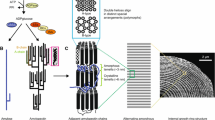Abstract
The activities of potato nucleotide pyrophosphatase and cyclic nucleotide phosphodiesterase against a common substrate, p-nitrophenyl thymidine 5′-phosphate and its histochemical analogue, AS-BI-naphthyl thymidine 5′-phosphate, were determined with the aid of relatively specific inhibitors, NAD and 2′,3′-cAMP, respectively. These inhibitors were utilized to reexamine wheat (Triticum aestivum L. cv. Mironovska 808) seeds and 3–5-d old shoots for the occurrence and histochemical localization of nucleotide pyrophosphatase, and to establish the localization of cyclic nucleotide phosphodiesterase. Nucleotide pyrophosphatase is a cytoplasmic enzyme found to be particularly active in the coleoptile epidermis and hypodermis, leaf mesophyll, as well as in developing fibres and phloem. Cyclic nucleotide phosphodiesterase is also a cytoplasmic enzyme active in the shoot vascular bundles, particularly the xylem, and in the seed. Within the seed it is highly active in the crushed cell layer adjacent to the scutellum and in endosperm cells adjacent to the aleurone layer. Within the embryo, cyclic nucleotide phosphodiesterase is most active in epithelial cells adjacent to the crushed cell layer, the suspensor, radicle and root-cap, as well as in the pro-vascular tissues of the scutellum.
Similar content being viewed by others
References
Ashton, A.R., Polya, G.M. (1975) Higher-plant cyclic nucleotide phosphodiesterases, Resolution, partial purification and properties of three phosphodiesterases from potato tuber. Bichem. J. 149, 329–339
Brewin, N.J., Northcote, D.H. (1973) Partial purification of a cyclic AMP phosphodiesterase from soybean callus. Isolation of a non-dialysable inhibitor. Biochim. Biophys. Acta 320, 104–122
Clayton, R.A., Hanselman, L.M. (1960) Tobacco nucleotide pyrophosphatases. Arch. Biochem. Biophys. 87, 161–166
Gahan, P.B., McLean, J., Kalina, M., Sharma, W. (1967) Freezing sectioning of plant tissues: the technique and its use in plant histochemistry. J. Exp. Bot. 18, 151–159
Gahan, P.B., Sierakowska, H., Dawson, A.L. (1979) Nucleotide pyrophosphatase activity in dry and germinated seeds of Triticum, and its relationship to general acid phosphatase activity. Planta 145, 159–166
Kole, R., Sierakowska, H., Shugar, D. (1976) Novel activity of potato nucleotide pyrophosphatase. Biochim. Biophys. Acta 438, 540–550
Kornberg, A., Pricer, W.E. (1950) Nucleotide pyrophosphatase. J. Biol. Chem. 182, 763–778
Lin, P.P., Varner, J.E. (1972) Cyclic nucleotide phosphodiesterase in pea seedlings. Biochim. Biophys. Acta 276, 454–474
Matsuzaki, H., Hashimoto, Y. (1981) Purification and characterization of acid phosphodiesterases of cultured tobacco cells. Agric. Biol. Chem. 45, 1317–1325
Moses, H.L., Rosenthal, A.S., Beaver, D.L., Schuffman, S.S. (1966) Lead ion and phosphatase histochemistry. II. The effect of adenosine triphosphate hydrolysis by lead ion on the histochemical localization of adenosine triphosphatase activity. J. Histochem. Cytochem. 14, 702–710
Payne, J.F., Bal, A.K. (1974) Histochemical detection of cyclic nucleotide phosphodiesterase activity in germinating onion seed. Plant Sci. Lett. 2, 319–330
Pearse, A.G.E. (1968) Histochemistry, theoretical and applied, vol. 1. J. and A. Churchill. London
Razzell, W.E., Khorana, H.G. (1961) Studies on polynucleotides. Enzymic degradation. Some properties and mode of action of spleen phosphodiesterase. J. Biol. Chem. 236, 1144–1149
Razzell, W.E. (1966) Plant tissue phosphodiesterase activities. Biochem. Biophys. Res. Commun. 22, 243–247
Razzell, W.E. (1968) Polynucleotidase activity of animal and plant tissue phosphodiesterases. Can. J. Biochem. 46, 1–7
Roberts, D.W.A. (1959) The hydrolysis of diphosphopyridine nucleotide by juice expressed from wheat leaves. J. Biol. Chem. 234, 655–657
Shinshi, H., Miwa, M., Kato, K., Noguchi, M., Matsushima, T., Sugimura, T. (1976) A novel phosphodiesterase from cultured tobacco cells. Biochemistry 15, 2185–2190
Sierakowska, H., Gahan, P.B., Dawson, A.L. (1978) The cytochemical localization of nucleotide pyrophosphatase activity in plant tissues using naphthyl esters of thymidine-5′-phosphate. Histochem. J. 10, 679–693
Vandepeute, J., Huffaker, R.C., Alvarez, R. (1973) Cyclic nucleotide phosphodiesterase activity in barley seeds. Plant Physiol. 52, 278–282
Author information
Authors and Affiliations
Rights and permissions
About this article
Cite this article
Bartkiewicz, M., Sierakowska, H. Histochemical localization of nucleotide pyrophosphatase and cyclic nucleotide phosphodiesterase in seeds and shoots of Triticum . Planta 155, 204–211 (1982). https://doi.org/10.1007/BF00392717
Received:
Accepted:
Issue Date:
DOI: https://doi.org/10.1007/BF00392717




